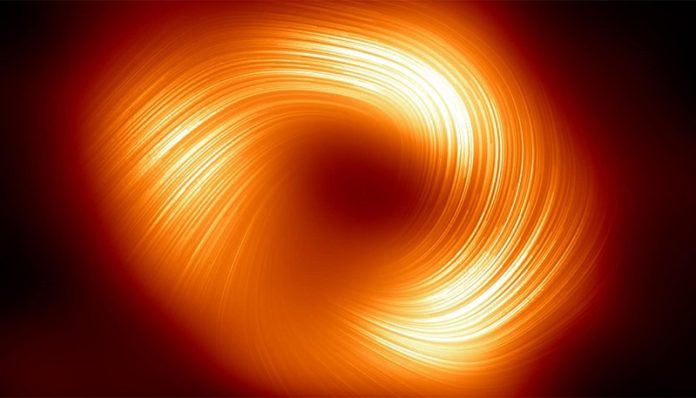
Astronomers have made an exciting discovery at the heart of our Milky Way galaxy.
Using a powerful tool called the Event Horizon Telescope (EHT), they’ve taken a special kind of image of the supermassive black hole known as Sagittarius A* (or Sgr A* for short), which sits right at the center of our galaxy.
For the first time, they’ve been able to see strong magnetic fields spiraling around the black hole, thanks to a technique that captures the light in a way that highlights these magnetic fields.
This discovery is making waves because it shows that Sgr A*, though much smaller than a giant black hole in another galaxy called M87*, has similar magnetic fields swirling around it.
This suggests that such magnetic fields might be a common feature around all black holes.
This is a big deal because it could explain how black holes affect their surroundings, including how they might shoot out jets of material into space.
The team’s work, shared in the journal The Astrophysical Journal Letters, builds on previous images of Sgr A* unveiled in 2022.
Those images were groundbreaking too, but this new look in polarized light – a type of light that lets scientists see the direction in which waves are vibrating – provides even deeper insights.
Boris Georgiev and Sara Issaoun, two of the researchers involved, explained how these magnetic fields around Sgr A* resemble those seen around the much larger M87* black hole.
This similarity hints at a hidden jet in Sgr A*, something that scientists are eager to learn more about.
Polarized light is all around us, but we can’t distinguish it with the naked eye. Around these black holes, the light gets twisted by the magnetic fields, allowing astronomers to map out how the fields are oriented.
Angelo Ricarte, another team member, shared how this helps us understand more about the black hole’s environment and the gas it pulls in.
Capturing these images wasn’t easy, especially because Sgr A* doesn’t stay still for the camera. It changes so fast that getting a clear picture is a real challenge.
Dan Marrone, one of the EHT’s co-principal investigators, described how they developed new instruments to detect the polarized radio waves from this fast-changing black hole.
These findings are more than just pretty pictures. They help scientists refine their computer models of black holes and better understand the physics happening near them.
Chi-kwan Chan, a professor involved in the project, mentioned how this new data improves our understanding of what happens close to a black hole.
The EHT isn’t stopping here. They’re planning more observations with even more telescopes and new techniques. Amy Lowitz and Remo Tilanus, part of the EHT team, talked about future projects that could allow us to see high-quality “movies” of black holes, revealing more about their behavior and even discovering hidden jets.
The EHT team at the University of Arizona is gearing up for more observations, including a set scheduled for April. With a bigger team and more telescopes, they hope to capture even more detailed images of these cosmic giants.
Andrew Thomas West and Jasmin Washington, two members of the team, shared their excitement for what these future observations might reveal about the mysterious and fascinating environments around black holes.



